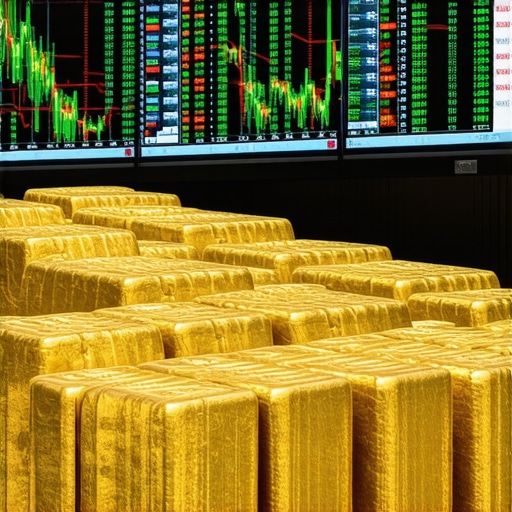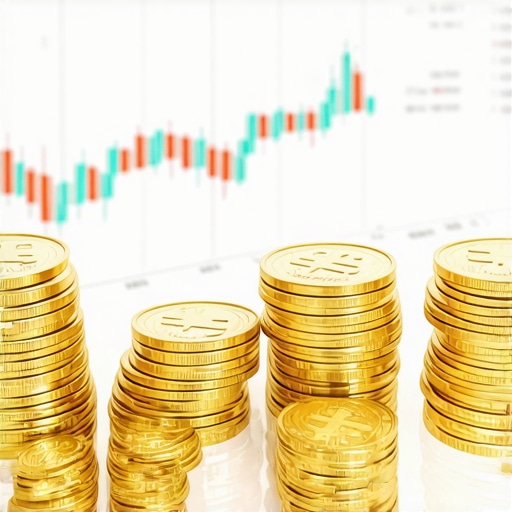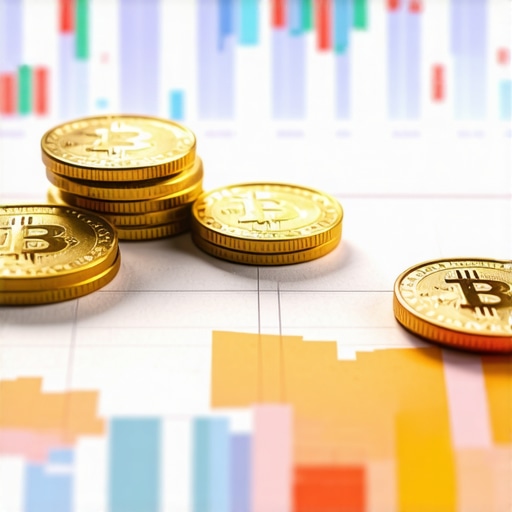Decoding the Influence of Central Bank Gold Reserves on 2025 Market Dynamics
As global economic uncertainties persist, central banks’ gold purchasing behaviors have garnered increased attention from investors and analysts alike. These sovereign entities, traditionally seen as custodians of monetary stability, now play an active role in shaping the precious metal’s trajectory, particularly as we approach 2025. Their strategic acquisitions are not merely reserve management; they are signals of underlying economic sentiment and long-term fiscal strategies. Understanding how these purchases influence gold prices requires a nuanced analysis of macroeconomic trends, geopolitical tensions, and monetary policy shifts.
The Nexus Between Central Bank Buying and Gold Price Formation
Central banks’ gold acquisitions can significantly impact supply-demand dynamics, especially when they shift from passive holders to active buyers. When nations buy gold to diversify reserves or hedge against currency devaluation, they effectively reduce available supply in the market, exerting upward pressure on prices. This behavior is often driven by concerns over fiat currency stability amid inflationary pressures and geopolitical uncertainties. Moreover, the scale and timing of these purchases can catalyze market sentiment, prompting retail and institutional investors to reassess their holdings.
How do central bank gold purchases influence investor confidence and market stability?
Central banks’ accumulation of gold often signals a commitment to monetary resilience, reassuring markets amid volatility. This behavior can bolster investor confidence, especially when it indicates a strategic move away from reliance on unstable fiat currencies. However, excessive buying might also spark fears of currency devaluation or economic instability, leading to increased volatility and speculative activity. Therefore, the net effect depends on coordination with broader monetary policies and geopolitical signals.
Projected Trends and Analytical Frameworks for 2025
Forecasting the impact of central bank gold purchases on 2025 prices involves integrating quantitative models with geopolitical risk assessments. Market analysts leverage tools such as comprehensive gold market analysis and technical indicators to gauge potential price movements. The anticipated increase in reserve diversification, especially among emerging economies, suggests a bullish bias for gold, contingent upon inflation trajectories and dollar strength. Additionally, the evolving landscape of gold mining stocks and ETFs further influence the price dynamics, creating a complex interplay of supply-side and demand-side factors.
What are the key geopolitical and economic variables that could amplify or dampen the impact of central bank gold buying in 2025?
Factors such as US dollar fluctuations, inflation rates, geopolitical conflicts, and monetary policy shifts among major economies will critically shape how central bank gold purchases translate into price movements. For example, if inflation remains high and dollar strength wanes, central banks’ gold buying may accelerate, pushing prices higher. Conversely, stabilization of global markets or a shift towards alternative reserve assets could mitigate these effects. Investors should also monitor emerging demand factors, including jewelry, technology, and investment sectors, which interplay with central bank activities.
For a comprehensive understanding of how these elements coalesce, explore market analysis and future price drivers.
Engaging with this evolving landscape requires a strategic approach grounded in expert insights. To deepen your understanding, consider reviewing long-term gold investment strategies for 2025 or contributing your analysis to our community of financial experts.
Examining Central Bank Gold Purchases as a Market Catalyst in 2025
Central banks’ gold accumulation strategies are increasingly viewed as pivotal indicators of global economic health. As nations diversify their reserves and hedge against fiat currency volatility, their buying patterns influence market confidence and price stability. The interplay between these sovereign actions and broader macroeconomic trends underscores the importance of understanding reserve management as a driver of 2025 gold price trajectories.
How Do Central Bank Gold Reserves Reflect Broader Economic Sentiments?
When central banks increase their gold holdings, it often signals concerns over currency devaluation, inflation, or geopolitical tensions. These reserve shifts can ripple through markets, affecting investor perceptions and behavior. Experts suggest that such moves are not isolated but part of a strategic stance towards long-term monetary resilience. For instance, recent data indicates that emerging economies, like China and Russia, have significantly ramped up their gold reserves, hinting at a move towards diversification away from the US dollar (source: comprehensive gold market analysis).
Could sovereign reserve strategies outpace traditional market drivers in shaping gold prices?
This question challenges investors to consider whether central bank policies could become the predominant influence on gold rather than conventional factors like inflation or dollar strength. Analyzing this shift involves assessing the evolving geopolitical landscape, monetary policy adjustments, and emerging demand sectors such as jewelry and technology. The strategic accumulation or disposal of gold by central banks might serve as a leading indicator for future price movements, especially if coordinated across multiple economies.
Leveraging Advanced Analytical Frameworks for 2025
Forecasting gold price trends in response to central bank activities necessitates an integration of macroeconomic models, geopolitical risk assessments, and technical analysis tools. For example, combining insights from comprehensive market analysis with real-time data on reserve changes can enhance predictive accuracy. Moreover, understanding the influence of emerging demand factors, including technological applications and jewelry consumption, adds depth to these forecasts.
Investors should also explore diversification strategies through top-tier options like gold mutual funds and ETFs, which can mitigate risks associated with geopolitical and policy shifts. These instruments provide liquidity and exposure aligned with macroeconomic trends, offering a balanced approach to capitalizing on central bank moves.
Are you equipped with the analytical tools to interpret central bank reserve signals effectively?
Developing this expertise involves staying informed about policy shifts, reserve data, and global economic indicators. Engaging with expert analyses and leveraging advanced technical tools, like gold futures technical analysis, can significantly enhance decision-making precision. For further insights, consider exploring strategies for building a resilient gold portfolio that aligns with your financial goals, such as long-term gold investment plans.
Strategic Reserve Management and Its Ripple Effect on Gold Valuations in 2025
As the global economic landscape continues to evolve amidst geopolitical tensions and monetary policy adjustments, central banks’ gold reserve strategies have become critical indicators of long-term economic resilience. These sovereign entities, once passive custodians, now actively manipulate their gold holdings to hedge against fiat currency vulnerabilities and to signal economic stability. This shift influences market perceptions and can catalyze significant price movements, especially when multiple nations coordinate their reserve policies.
Recent data suggests that countries like China and Russia are significantly ramping up their gold acquisitions, signaling a desire to diversify reserves away from the US dollar. According to the International Monetary Fund (IMF), central banks increased their gold reserves by approximately 650 tonnes in 2023, marking a pivotal trend towards diversification and financial sovereignty (IMF Report on Reserve Trends 2024).
How do these strategic shifts influence global market stability and investor confidence?
Such reserve strategies serve as a double-edged sword; while they bolster confidence in the long-term stability of a country’s economy, they can also introduce volatility into gold markets. A coordinated increase in reserves may precipitate a bullish trend, especially if driven by emerging economies seeking financial independence. Conversely, abrupt sell-offs or a lack of transparency could undermine market stability, leading to increased volatility and speculative activity.
Understanding these dynamics requires an appreciation of macroeconomic interplays and geopolitical signals. Investors should monitor central bank reserve reports, geopolitical developments, and macroeconomic indicators like inflation rates and dollar strength to anticipate potential market shifts.
Advanced Analytical Frameworks for Forecasting 2025 Price Movements
Forecasting the impact of reserve shifts on gold prices involves combining quantitative models with geopolitical risk assessments. Techniques such as machine learning algorithms applied to reserve data, combined with traditional technical analysis, enable a more nuanced prediction of price trends. Additionally, integrating macroeconomic indicators, such as inflation expectations and currency strength indices, provides a comprehensive view of potential market directions.
For example, the World Gold Council’s Reserve Impact Model offers valuable insights into how reserve changes correlate with price movements, allowing investors to fine-tune their strategies accordingly.
What innovative tools and data sources are emerging to enhance predictive accuracy in gold market analysis?
Advancements in real-time data analytics, satellite monitoring of physical gold reserves, and blockchain transparency initiatives are transforming how analysts interpret reserve movements. These technologies enable near-instantaneous updates and reduce information asymmetry, empowering investors with a competitive edge. Engaging with these tools can significantly improve decision-making precision, especially in a complex environment where reserve movements are subtle but impactful.
To deepen your analytical capabilities, explore platforms offering comprehensive gold market analytics and consider subscribing to expert newsletters that synthesize geopolitical and macroeconomic signals.
Integrating Reserve Strategies into a Holistic Investment Approach
While central bank reserve shifts are influential, they should be viewed within a broader investment context. Diversification across asset classes, including gold ETFs, mining stocks, and futures, can mitigate risks associated with geopolitical tensions and policy shifts. Furthermore, understanding the interplay between reserve movements and other market drivers—such as technological innovations and demand from emerging sectors—provides a strategic advantage.
If you aim to build a resilient, forward-looking gold portfolio, consider integrating insights from industry reports, expert analyses, and advanced predictive tools. Remember, the key to capitalizing on these macro trends lies in staying informed and adaptable.
Are you leveraging the latest analytical tools to interpret central bank reserve signals?
Staying ahead in the gold market requires a commitment to continuous learning and technological adoption. Platforms that offer real-time reserve data, combined with AI-driven predictive analytics, can enhance your market foresight. For tailored strategies, consult with financial experts specializing in macroeconomic and geopolitical risk analysis, ensuring your investment approach remains robust amidst evolving global dynamics.
Unveiling the Hidden Mechanics of Central Bank Gold Accumulation and Its Market Implications
In the intricate world of global finance, central banks’ gold reserve strategies serve as a sophisticated barometer of economic resilience and geopolitical intent. As we edge closer to 2025, understanding how these sovereign maneuvers influence market dynamics becomes crucial for investors seeking an edge in the precious metals arena. Central banks are shifting from passive reserve custodians to proactive market participants, with their gold purchases often signaling long-term strategic shifts rather than mere reserve diversification.
Deciphering the Impact of Sovereign Gold Policies on Price Formation
When central banks increase their gold holdings, the immediate effect often manifests as a tightening of available supply in the global market, thereby exerting upward pressure on prices. This phenomenon is particularly pronounced when multiple nations coordinate reserve adjustments, reflecting a collective move towards financial sovereignty and diversification from traditional fiat currencies. Such actions can generate a bullish sentiment among investors, reinforcing gold’s role as a safe haven asset amidst geopolitical tensions and monetary policy uncertainties.
What is the significance of central bank gold purchases in shifting investor trust and market stability?
Strategic gold acquisitions by central banks act as a form of monetary reassurance, bolstering market confidence during turbulent periods. Conversely, abrupt selling or opacity in reserve management can introduce volatility, prompting market participants to reassess risk. These reserve policies, especially when transparently communicated, can serve as a stabilizing force, underpinning gold’s appeal as a hedge against systemic risks—a vital consideration for sophisticated investors aiming to optimize portfolio resilience.
Forecasting 2025: Advanced Models and Emerging Variables
Predictive frameworks now incorporate machine learning algorithms that analyze reserve data alongside macroeconomic indicators such as inflation expectations, currency strength indices, and geopolitical risk scores. The integration of real-time satellite monitoring and blockchain transparency initiatives further refines our understanding of physical gold movements, enabling a more precise anticipation of price trajectories. According to the World Gold Council’s Reserve Impact Model, these technological advancements are revolutionizing how market analysts interpret reserve shifts and their correlation with price volatility.
How can investors leverage emerging analytical tools to decode central bank reserve signals effectively?
Adopting AI-driven predictive analytics, satellite intelligence, and blockchain data enhances one’s ability to detect subtle reserve movements ahead of market shifts. Engaging with expert-led platforms offering comprehensive data feeds and trend analyses can significantly elevate strategic decision-making. For those committed to staying ahead, integrating these tools into a cohesive investment strategy is essential for navigating the complex interplay of reserve management and market psychology.
Reserves as a Catalyst for Market Confidence and Economic Sovereignty
As countries like China and Russia diversify their reserves, their strategic accumulation of gold not only reflects internal economic policies but also signals a broader shift towards de-dollarization. These reserve movements often precede or accompany geopolitical realignments, adding another layer of complexity to market analysis. The IMF’s recent report (IMF Reserve Trends 2024) highlights a significant upward trend in gold holdings among emerging economies, underscoring a collective move towards financial independence.
Could sovereign reserve strategies become more influential than traditional market drivers like inflation or dollar strength?
This evolving paradigm suggests that central bank policies may increasingly dictate gold price movements, especially if coordinated across major economies. Investors should monitor reserve reports, geopolitical developments, and macroeconomic indicators like inflation rates and dollar indices to anticipate these shifts. Recognizing the signals embedded within reserve adjustments can provide a strategic advantage in timing entry and exit points.
Harnessing Cutting-Edge Analytical Tools for Strategic Foresight
Emergent technologies such as AI, satellite tracking, and blockchain transparency are redefining market analysis. Platforms that synthesize real-time reserve data with geopolitical and macroeconomic signals empower investors with unprecedented predictive accuracy. For example, the World Gold Council’s Reserve Impact Model exemplifies the potential of combining data science with financial analysis to forecast price trends with greater confidence.
To capitalize on these innovations, investors should consider subscribing to specialized analytics services and engaging with expert communities focused on macroeconomic and geopolitical risk assessment. Staying informed about technological advancements will be vital in maintaining a strategic edge in the evolving landscape of gold markets.
Expert Insights & Advanced Considerations
1. Central bank reserve diversification signals a long-term shift towards financial independence, impacting gold demand and prices.
As emerging economies ramp up their gold holdings, this strategic move not only reflects geopolitical intentions but also signals a move away from dollar dominance, shaping market dynamics well into 2025.
2. Advanced analytical tools like machine learning models and satellite monitoring are revolutionizing how investors interpret reserve movements, offering a competitive edge.
Integrating real-time geopolitical data with macroeconomic indicators enables more precise forecasting of gold price trajectories, essential for sophisticated asset management.
3. The growing influence of sovereign reserve policies may surpass traditional drivers like inflation, positioning central bank actions as pivotal in gold market analysis.
Understanding these shifts requires ongoing vigilance of reserve reports, geopolitical developments, and macroeconomic signals, emphasizing the importance of advanced data analytics in strategic decision-making.
4. Technological innovations such as blockchain transparency and AI-driven predictive analytics are enhancing transparency and accuracy in reserve data interpretation.
Investors leveraging these tools can anticipate market movements more effectively, ensuring better timing and risk management in their gold investments.
5. Diversification strategies—including gold ETFs, mining stocks, and futures—remain vital in mitigating risks associated with geopolitical and monetary policy shifts, especially as reserve strategies evolve.
Building a resilient portfolio involves integrating insights from comprehensive market analysis and emerging demand sectors, ensuring long-term wealth preservation amidst market volatility.
Curated Expert Resources
- World Gold Council’s Reserve Impact Model: Offers advanced insights into how reserve shifts influence gold prices, essential for strategic forecasting.
- IMF Reserve Trends Reports: Provides authoritative data on global reserve movements, crucial for understanding macroeconomic trends.
- Gold Analytics Platforms: Utilize real-time data analytics, satellite monitoring, and blockchain transparency to enhance predictive accuracy.
- Financial Expert Communities: Engage with professional networks focused on macroeconomic and geopolitical risk assessment for nuanced insights.
Final Expert Perspective
In navigating the evolving landscape of gold investments, understanding the influence of central bank gold reserves is paramount. These sovereign actions are increasingly shaping market trends and can outperform traditional economic drivers. Embracing cutting-edge analytical tools and strategic diversification positions investors to capitalize on upcoming opportunities in 2025. For those committed to expert-level investing, continuous learning and technological adoption are the keys to sustained success. To deepen your mastery, explore top gold mining stocks and consider engaging with professional analysis platforms that synthesize macroeconomic, geopolitical, and reserve data for comprehensive market insights.










